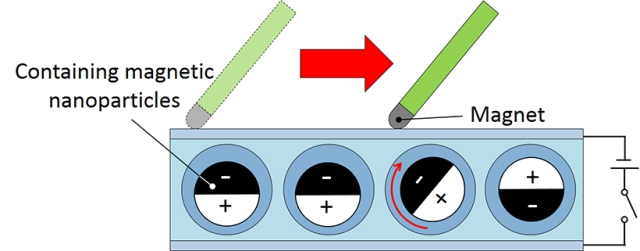Apr 22 2015
 The black side of the microparticles contains magnetic nanoparticles that make it possible to write on the screen. A magnet pulled across the surface of the white display attracts the black side and the balls flip to face the magnet. CREDIT: Yusuke Komazaki/ University of Tokyo
The black side of the microparticles contains magnetic nanoparticles that make it possible to write on the screen. A magnet pulled across the surface of the white display attracts the black side and the balls flip to face the magnet. CREDIT: Yusuke Komazaki/ University of Tokyo
Based on an old e-paper concept, a team of researchers from the University of Tokyo have created an economical handwriting-enabled e-paper which is ideal for large displays such as whiteboards.
E-paper technology was pioneered in the 1970s; however the writing feature in e-paper development has been slack. So far, handwriting-enabled displays have mainly been used in economical feature-limited area of children's toys, and in the exclusive area of smart pens and touch-screen e-readers.
The University of Tokyo researchers have upgraded this existing e-paper technology to develop a robust and economical display which can behave like a whiteboard when there is a need for a large writing space. The display has been designed using bicolored microparticles measuring approximately 0.1mm in diameter. Each particle has two hemispheres, black and white, carrying negative and positive charge respectively.
Two electrodes sandwich these particles. When the voltage direction is switched across the electrodes, it is possible for the background display to switch between black and white. Although, this type of "twisting ball" displays have been in existence, these researchers are leaders in combining a magnetic field control part with the original electric control.
Apart from generating a negative charge, the microparticle’s black side also consists of magnetic nanoparticles which enable writing on the screen. When a magnet is pulled across the white display’s surface, it attracts the black side, and the balls turn over to face the magnet, thereby images and lines are drawn on the display. The magnet used just needs to possess about the same strength as a refrigerator magnet.
When voltage is applied, it will instantly erase the drawings. Likewise, when there is no voltage or magnetic field, the image remains without using any energy.
Toughness, cost, size and color are the advantages of our e-paper display. The display is made from materials like acrylic polymer, silicone elastomer, and silicone oil that are relatively inexpensive and hold up well under UV light. Because of the e-paper's simple structure, large displays can be easily fabricated. In addition, the researchers could easily change the color combinations by substituting different microparticle pigments.
Yusuke Komazaki - Researcher at the University of Tokyo
The researchers feel that energy-saving, economical, lightweight electronic whiteboards are an ideal application for the new e-paper.
"Conventional electronic whiteboards are equipped with large LCDs or projectors and are very expensive, less visible in bright light conditions, heavy, and energy consuming," Komazaki said. "It is very much likely that these novel displays have multiple competitive advantages."
"If we fabricate super-large displays, it might even be possible to replace traditional blackboards in classrooms," Komazaki said.
Going forward, the team is keen to enhance the display’s contrast by increasing the black and white pigment quantity in the microparticles. They believe their work will eventually make the world much less reliant on traditional paper.
"Writing and drawing is an indispensable feature of paper, so we believe that our handwriting-enabled e-paper is closer to real paper than conventional e-papers," said Komazaki. "Someday, handwriting-enabled e-paper may replace real paper."
The illustration of the e-paper can be found in the Journal of Applied Physics, from AIP Publishing.